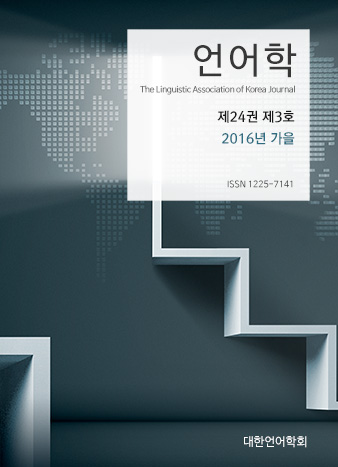대한언어학회 전자저널

24권 3호 (2016년 9월)
Abstract
Yune, Suejin. (2016). Perception of English Approximants by Korean-speaking Students. The Linguistic Association of Korea Journal, 24(3), 63-85. This paper examines Korean speakers perception of English approximants [l], [r], [w], [j] which are thought to be difficult sounds for Korean-speaking English learners. Experimental studies were conducted to examine which sound(s) is the most difficult to perceive among the four English approximants and whether English proficiency plays a significant role when perceiving approximants. For this purpose, an identification test and discrimination test were implemented on 61 college students with two English proficiency levels: high proficiency (HP), and low proficiency (LP). The 4 stimuli are real English words beginning with each target sound. The result of the identification test showed that [r] and [w] were the least detectable sounds for high proficiency level. The result of discrimination test indicated that [l]-[r] sounds pairs (lap-rap, and rap-lap) were the most difficult sound pairs. Interestingly, the lap-rap pair was significantly less recognized than the rap-lap pair regardless of the participants' proficiency level.
Keywords
# English approximants # liquids # glides # perception # English proficiency
References
- Best, C., T. & Strange, W. (1992) Effects of phonological and phonetic factors on cross-language perception of approximants, Journal of Phonetics, Vol. 20(3), 305-330
- Ingram, J., C., L. & Park, S.-G. (1998) Language, context, and speaker effects in the identification and discrimination of English /r/ and /l/ by Japanese and Korean listeners, Journal of Acoustical Society of America, 103(2), 1161-1174
- Jamieson, D. G. & Yu, K. (1996) Perception of English /r/ and /l/ speech contrasts by native Korean listeners with extensive English-language experience, In Proceedings of ICSLP 96 the Fourth International Conference on Spoken Language Processing, vol. 3, 1453-1456
- Jun, E. (2003) The perception of English /l/ and /r/ by Korean speakers, Studies in Phonetics, Phonology and Morpholgy 9, Issue 02, 471-484
- Kang, H. (2006) An Acoustic Study of the Perceptual Significance of F2 Transition of /w/ in English and Korean, Speech Sciences, Vol. 13, Issue 04, 7-21
- Kim, M.-R. & Lotto, A. J. (2004). Acoustic measurements of Korean approximants. In H.-Y, Kim (Ed.) The Korean Language in America 9 (pp.70-77). American Association of Teachers of Korean
- Ladefoged, P. (1982) A Course in Phonetics 2ndEd., NewYork: Harcourt Brace Jovanovich, Inc.
- Ladefoged, P. (2005) Vowels and Consonant 2ndEd., Oxford: Blackwell Publishing.
- MacKain, K., S., Best, C., T. & Strange, W. (1981) Categorical perception of English /r/ and /l/ by Japanese bilinguals, Applied Psycholinguisitcs, Vol. 2, Issue 04, 369-390
- Park, S.-G. & Ingram, J. (1995) /l/ & /r/ Perception by Korean and Japanese Speakers Learning English: The Relative Importance of L1 Transfer Effects and Universal Acoustic Factors, Korean Journal of Linguistics, 20(4), 87-109
- Shin, J. (2012) Hangueoui Malsori, Seoul, Jisikgwagyoyang.
- Yavas, M. (2006) Applied English Phonology, Oxford: Blackwell Publishing.